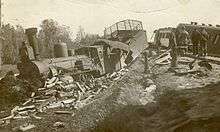Franz Krull Sk class
The Franz Krull Sk-class is a class of steam locomotive built by the Franz Krull metal works of Tallinn, Estonia between 1931-1940.
| Franz Krull Sk class | |||||||||||||||||||||||||
|---|---|---|---|---|---|---|---|---|---|---|---|---|---|---|---|---|---|---|---|---|---|---|---|---|---|
 Sk-154 | |||||||||||||||||||||||||
| |||||||||||||||||||||||||
| |||||||||||||||||||||||||
| |||||||||||||||||||||||||
The Sk were narrow-gauged and used oil shale as fuel, since it is the primary energy source in Estonia. A total of 16 units were produced, of which none has survived. The last Sk, Sk-156, was scrapped in 1980 in Beloretsk, Russia, where it was actively used until scrapping.
List of Sk locomotives

Sk-155 after the railway accident between stations Võhma and Olustvere.
Built in 1931:
- Sk-151
- Sk-152
- Sk-153
- Sk-154
- Sk-155
- Sk-156
- Sk-157
- Sk-158
- Sk-159
- Sk-150
Built in 1935:
- Sk-160
- Sk-161
- Sk-162
Built in 1940:
(During the first Soviet occupation of Estonia, when the factory was renamed "Punane Krull" ("Red Krull"). These locomobiles were decorated by the red star and hammer and stickle figures.)
- Sk-163
- Sk-164
- Sk-165
gollark: ++eval-polish + 1 1
gollark: ++ping
gollark: ++exec```haskellhaskell```
gollark: ++exec```haskellhaskell = haskell```
gollark: ++exec```haskellhaskell = haskell```
External links
- Mulgi Railway
- History of Estonian narrow-gauge railways (in Estonian)
This article is issued from Wikipedia. The text is licensed under Creative Commons - Attribution - Sharealike. Additional terms may apply for the media files.